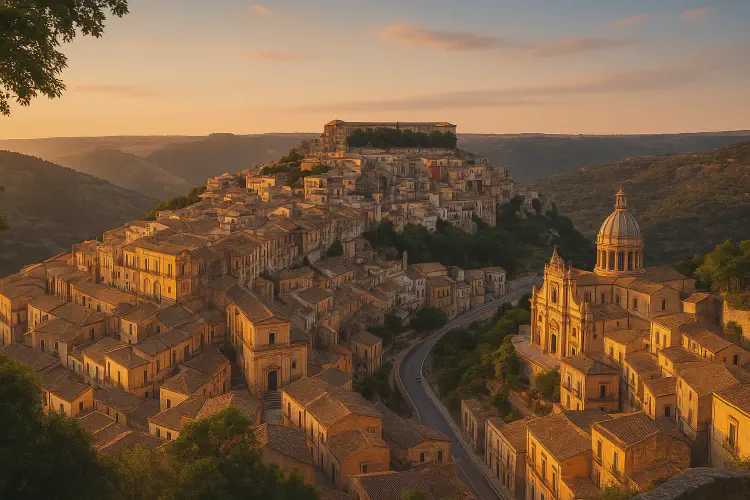Baroque towns: Ragusa, Modica, Noto
After the devastating earthquake of 1693, Sicily’s southeastern region was reborn in a blaze of **Baroque architecture**. The towns of **Ragusa, Modica, and Noto** rose from the ruins, becoming masterpieces of urban design and artistry that today form part of a UNESCO World Heritage Site.
- Visit Sicily
- 3 min read

Baroque Towns: Ragusa, Modica, and Noto
🏛️ Overview
The Val di Noto, in southeastern Sicily, represents one of the finest concentrations of Late Baroque architecture in Europe. Entire towns were rebuilt in ornate, harmonious styles after the 1693 earthquake, resulting in a cultural landscape of breathtaking beauty and balance.
Each town — Ragusa, Modica, and Noto — has its own character, charm, and rhythm, yet all share the same artistic grandeur that defines Sicily’s Baroque heart.
🌆 Ragusa — The City of Two Souls
Ragusa is divided into two parts: Ragusa Superiore (the modern upper town) and Ragusa Ibla (the ancient lower town), connected by stairways and scenic bridges.
Highlights:
- Duomo di San Giorgio: a stunning example of Sicilian Baroque with an elegant façade and panoramic staircase.
- Giardino Ibleo: peaceful public gardens with palm trees and views of the surrounding valleys.
- Via del Mercato and Corso XXV Aprile: charming lanes filled with artisan shops and cafes.
- Ragusa Ibla at sunset: a photographer’s dream — a maze of golden limestone and church domes glowing in warm light.
Ragusa feels atmospheric and quiet, perfect for wandering and soaking in the layered beauty of Sicilian Baroque.
🍫 Modica — Baroque and Chocolate
Built on the slopes of a gorge, Modica is famous not only for its churches but also for its ancient chocolate-making tradition, introduced by the Spanish using Aztec techniques.
Highlights:
- Duomo di San Giorgio: Modica’s crown jewel, with 250 steps leading to a majestic church façade.
- Duomo di San Pietro: another Baroque marvel with statues of the apostles along its staircase.
- Antica Dolceria Bonajuto: Sicily’s oldest chocolate shop, producing grainy, aromatic chocolate bars flavored with cinnamon, chili, or vanilla.
- Scenic viewpoints: the terraces above Modica offer spectacular panoramic views, especially at dusk.
Modica combines artistic splendor with culinary delight — a feast for both eyes and taste buds.
🕍 Noto — The Baroque Jewel of Sicily
Often called “the Garden of Stone”, Noto is a symphony of honey-colored limestone and harmonious urban planning.
Highlights:
- Noto Cathedral (Cattedrale di San Nicolò): rebuilt after its collapse in 1996, it gleams with restored Baroque grace.
- Corso Vittorio Emanuele: the town’s elegant main street, lined with palaces, churches, and cafes.
- Porta Reale: the grand archway welcoming visitors into Noto’s historical core.
- Palazzo Nicolaci di Villadorata: famous for its ornate balconies with grotesque masks and mythological figures.
- Teatro Comunale and Church of San Domenico: architectural highlights showcasing the city’s artistic balance.
Visit in May to see the Infiorata di Noto, a flower festival transforming the streets into colorful carpets of petals.
🚗 Getting There and Around
- The towns are close to each other: Ragusa ↔ Modica (15 km), Modica ↔ Noto (40 km).
- By car: the best way to explore the region’s hilly terrain and hidden countryside.
- By train: regional services connect all three towns, though schedules can be limited.
🍷 Food and Local Experiences
- Enjoy local wines like Nero d’Avola and Moscato di Noto.
- Sample Modica chocolate, almond pastries, and fresh ricotta desserts.
- Stay in restored palazzi or rural agriturismi for authentic hospitality.
🧭 Summary
Ragusa, Modica, and Noto are the triumvirate of Sicilian Baroque — elegant, atmospheric, and steeped in history. Walking their streets feels like stepping into an open-air museum, where every corner tells a story of resilience, artistry, and rebirth. These towns showcase the soul of southeastern Sicily, blending beauty, craftsmanship, and living tradition.